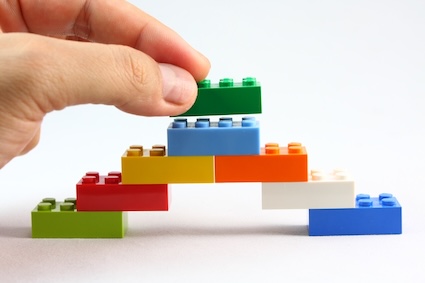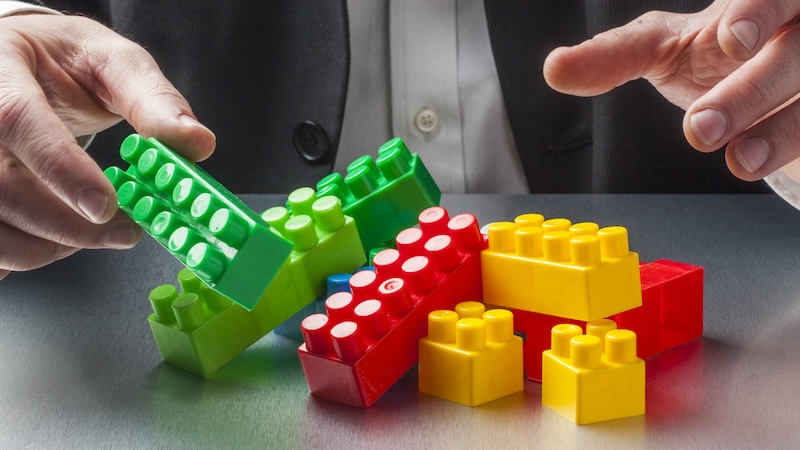The first image of building structures with colorful Lego bricks is of preschoolers, kindergartners, and other children. Now, you can expand that image to include seniors, using Lego bricks to benefit people with dementia, Alzheimer’s, and other cognitive issues – as well as those in the general population.
Benefits of Lego play
Lego-based therapy was developed in the mid-1990s to improve social skills in children with autism spectrum disorders. More recently, the practice has been broadened to include other populations, specifically as a non-pharmaceutical approach to dementia care. By harnessing the power of play and creativity, the program helps improve cognitive function, spark joy, promote social connections, and reignite a sense of purpose.
Related: The Benefits of Play for Seniors
Research has shown that this hands-on therapy activates areas of the brain associated with spatial awareness and problem-solving, stimulating the brain’s sensory processing centers and enhancing cognitive and even social engagement.
As another example of using Lego bricks to benefit people with dementia, the meditative quality of building can reduce anxiety and agitation, common symptoms of Alzheimer’s. As participants work on their creations, they are also rekindling a sense of memory, autonomy, and self-expression, which can be a potent antidote to the feelings of frustration and disempowerment that often accompany Alzheimer’s.
Natalia Kasperovich developed the Bricks for Better Brains program specifically for older adults, both those in the general population and individuals living with dementia. The organization’s programs are “designed to improve quality of life, slow the cognitive effects of aging, and protect and enhance the health of our brains.”
 A project-based approach for all older adults offers structured, goal-oriented activities. An experience-based approach for people with dementia focuses on sensory engagement, interaction, and exploration, with long-term participation offering the best outcomes.
A project-based approach for all older adults offers structured, goal-oriented activities. An experience-based approach for people with dementia focuses on sensory engagement, interaction, and exploration, with long-term participation offering the best outcomes.
The concept is based on emerging brain research in the sub-field of expressive art therapies. Consistent with recent research in the field of cognitive wellness, the Lego-based activities offer multi-domain stimulation. They incorporates elements of art therapies, cognitive-motor integration, and mindfulness training with the goals of reducing loneliness, promoting social engagement, stimulating play in adulthood and offering an enriched environment.
Enhancing tactile stimulation
One important element of interlocking Lego bricks is tactile stimulation. According to a how do hands work report by the National Library of Medicine,
Our hands have very sensitive “antennae” for receiving information from the environment. There are a total of 17,000 touch receptors and free nerve endings in the palm. These pick up sensations of pressure, movement and vibration.
Each act of picking up, connecting, and removing Lego bricks activates numerous touch receptors and nerve endings, even many that might not be engaged during everyday activities. The repeated actions between the brain, the hands, and the fingers trigger neuro-electrochemical reactions that are building bricks of neuro-plasticity. Since hand function diminishes with age, simple and regular hand exercises help to minimize functional aging changes.
Participants in the Bricks for Better Brains Program are encouraged to do hand exercises in class and out. Learning by making provides cognitive stimulation, discovery, respect for non-traditional mediums, and opening the mind to new ideas and experiences. Each session is designed to not only stimulate participants’ brains for effective cognitive and behavioral responses, but also to decrease anxiety and stress and improve engagement.
A non-pharmaceutical cognitive intervention
Studies show that non-pharmacological therapies (NPTs) have excellent potential to improve cognition in people with dementia.
A study on the efficacy of a non-pharmaceutical multimodal intervention program in a group setting for patients with mild cognitive impairment (MCI) concluded that an eight-month non-pharmaceutical group-based intervention program consisting of physical exercise, cognitive stimulation, and health education lectures could contribute to slowing cognitive decline, which may be used for maintaining cognitive performance in patients with mild cognitive impairment.
The traditional approach to Alzheimer’s care often focuses on medication and behavioral management, which can be effective in alleviating symptoms but often lag in addressing the emotional, social, and cognitive needs of individuals living with Alzheimer’s.
Therapy using Lego bricks to benefit people with dementia has emerged as an engaging and meaningful non-pharmacological intervention offering an innovative approach to Alzheimer’s care that addresses the emotional, social, and cognitive needs of individuals living with Alzheimer’s.
